

Home | Spaceship Earth | Book Reviews | Buy a Book | Bean and Grain Index | Short Stories | Contact | Mud Blog
By Dan Armstrong
The Southern Willamette Valley Bean and Grain Project held its annual meeting and potluck dinner on April 8, 2014 at the Long Tom Grange. The meeting was both a social gathering and an opportunity to review the work and progress of the Bean and Grain Project since its inception in 2008.
The discussion took place over a dinner that was served outside on a stunning evening in a beautiful little nook in the Long Tom watershed. In attendance were Paul Harcombe from Horseshoe Lake Farm and Fertile Valley Seed Company, Andrew Still from Adaptive Seeds, Jeff Broadie from Lonesome Whistle Farm, Ian Gallacher from Lord's Bounty Farm, Dick Wadsworth from Greenfield Farm, Harry MacCormack from Sunbow Farm, Al Dong from Noti, Shepard Smith of Soil Smith Services, Charlie Tilt, James Henderson, and Marcia Rae from Hummingbird Wholesale, Cassie Peters from Ten Rivers Food Web, and the hostesses for the night Lynne Fessenden and Leisha Wood from Willamette Farm and Food Coalition, who helped organize and set up the meeting. Special thanks to Lynne and Leisha.

The meeting began by giving each person at the table a chance to introduce themselves and relate their story with the Bean and Grain Project, then the food was served and we proceeded to an open discussion.
While each farm has had its successes and failures with one crop or another, a significant part of the conversation focused on farm size and how the application of field crops like grains fit into individual farm business models and the market system in general. After six years it seems that the larger farms (1000 acres plus) that have built mills and enlisted other growers to grow for their mills have the best working model. The Hunton Family Farm out of Junction City and Stalford Seed Farms out of Tangent are our best examples. Though neither farm was represented at the meeting, they both have had mills for three plus years and are continuing to expand their line of products. Both have the crop diversity to manage three-, four-, and five-year rotations and both have had considerable success with the production of high quality hard red wheat.
The smaller farms (less than 100 acres) have had a tougher time incorporating grains into their business model. For example, Lonesome Whistle Farm is in its fourth year at its new location. Lonesome Whistle runs a bean and grain CSA and has steadily expanded its small-scale processing capacity for value added products. The farm is growing, but is still managing a tight bottom line. While the CSA has worked, Lonesome Whistle's inability to grow organic grains at a cost that allows for profitable sale to local distributors is something that needs to be addressed. The large farms clearly have the advantage of scale to reduce production costs. Higher yielding grain varieties would help these smaller farms. However, this is not a new issue. The search for higher yielding organic grains has been an ongoing process for all the organic wheat growers in western Oregon regardless of size. Adding livestock to the smaller farms is an approach suggested by Steve Jones at the Bread Lab in Mount Vernon, Washington. With livestock, grain seconds, that might otherwise be lost to waste, can be used as animal feed. This eliminates the cost of buying feed and makes for a more sustainable and economical method for increasing soil fertility through livestock.
For the smaller scale homestead farm, the inclusion of beans and grains seems a must. Because self-determination and independence from the outside system are more important than profit for the homesteader, growing grains for the homestead family, for the farm livestock, and for the rotation value is something altogether different than growing grains or beans commercially. The difficulty for the homesteader, however, is processing. This must be done on a very small scale and often relies on the modification of existing machinery or handmade processing equipment. This can be ridiculously time consuming, but often inspires innovation. Handmade, small scale, seed cleaning and grain threshing devices are something Al Dong has been focused on in Noti. (See images below.)
From the beginning, the Bean and Grain Project has been an experiment in both horticulture and economic systems. Food security was the central impetus for the project. The local food model and the premise of getting the most from the Willamette Valley foodshed were key pieces of the philosophy. On a grander scale, it was imagined that the most sustainable way to feed the world was not to break the world's farming regions up into areas of monoculture, where each region produced the product that generated the most profit on the global market, but, rather, to enable each region to feed its population first from its own foodshed, then go outside that region for the products that could not be grown locally. In the ideal, this would facilitate maximum diversity for each region and through diversity minimize environmental degradation and maximize food security–as opposed to what we've witnessed after fifty plus years of industrial farming–large scale environmental degradation and deteriorating food security.
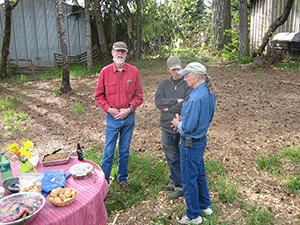

That said, a certain level of common sense and a willingness to adapt are necessary when we attempt to rebuild local food systems in the midst of a global system. Farm scale and related business models, as the 2014 Bean and Grain Project meeting discussion has revealed, are features of the local food system that we are still learning about.
For instance, early in the process of rebuilding the Willamette Valley's local food system, there was a desire for purity. That is, growing for the local market and the local market only. This was an ideal that has proven to be problematic. Our six-year experience is telling us that there must be flexibility in the model. The local producer can at times need the regional, national, or even global markets as outlets.
Imagine the various markets–local, regional, national, global–as Russian nesting dolls, one sitting within the other. A local producer is advised to sell locally first, usually at a premium for being local. Then if the local market is saturated, the producer sells his or her excess on the regional market. From the regional market, the producer proceeds, if necessary, to the national and lastly to the global market. Knowing that the premium, especially for organic, is tied to the proximity of the market, this translates into selling at the highest price and working down, and is a complete reversal of the existing market model–global first, national and regional next, and lastly local.
Of course, the flipside to these nested markets is competition from the encompassing and larger markets. Here in the Willamette Valley, we have already seen that wheat grown in eastern Oregon or Montana can be sold profitably at lower prices than is possible in western Oregon because of the differences in production scale. This dynamic is arguably the largest obstacle to the rebuilding of local food systems and will continue to be until the climbing price of petroleum or the influences of climate change or consumer awareness alter the market dynamics in favor of local production. That price is not the only reason for buying a product remains a difficult concept to instill in the consumer. The values of local food security, community health, and environmental protection continue to be seen as secondary to the forces of free market capitalism.
The positive side of the nested markets is that when it comes down to actually producing beans and grains for the Willamette Valley and Portland, it would be very easy to grow more wheat and also more beans than the our locale consumes. For example, the acreage necessary for all wheat and bean demand in our locale is roughly about 100,000 to 120,000 acres. Capturing 20% of that demand, which at this point would be considered a huge, huge accomplishment, could be achieved on as little as twenty or twenty-five thousand acres–meaning it would be relatively easy to out produce local demand. In that case, the model suggests–especially for organic products–selling excess regionally, and if any remains after that, which is more likely for wheat, it goes global. For farm survival, especially in the early years of transition, selling over-production regionally is just as much a part of our model as distributors buying regionally if they can't meet local demand with what we grow here. In the end, these are concepts that must be understood as we proceed.
1. Lonesome Whistle is continuing as a Bean and Grain CSA. They are growing dry corn for polenta, popcorn, dry beans, barley, oats (which they will be rolling), and several varieties of wheat that will be available as berries, flour, or bread. They have acquired a gravity table and it is available to be used at their farm for a fee.
2. Harry MacCormack recommended Indian Woman dry beans. They were his most successful beans last year both in production and sales.
3. Paul Harcombe is collaborating with Carol Deppe, growing out beans for her Fertile Valley Seed Company. Paul also recommended "Tille," a battery driven electric tiller created by Michael McGown. Brad Attig is the company's business manager. They have a store at 280 NW First Street in Corvallis.
4. Shepard Smith has expanded local grain production to include organic livestock feed.
5. A recurring theme in the discussion was that the weakest link in local food system remains the knowledge and skill for growing beans and grains. There is also concern for a shortage of young farmers interested in learning these skills.
6. Andrew Still said that Open Oak Farm has backed away from its CSA and placed its emphasis on growing and selling seed, so that the farm is now known as Adaptive Seed Company.
7. James Henderson, the buyer for Hummingbird Wholesale, verified the production and economic success of local hard red wheat and garbanzo beans. He said Hummingbird could use more organic barley, buckwheat, and garbanzos this year.
8. Charlie Tilt, the owner of Hummingbird Wholesale, said that Hummingbird is open to collaboration with local farmers, particularly in the capitalization of processing equipment.
9. There is interest in further exploration of quinoa production and processing. To date, the early returns are encouraging, but lygus bugs and late harvest are major concerns.
10. Ian Gallacher of Lord's Bounty Farm in Jefferson, Oregon was a newcomer to the group. He is growing corn and oats, among other things, and does a large part of his farming with horses.
11. Al Dong brought a small handmade seed cleaner to the meeting and demonstrated it for those in attendance. ( See images below.) Al said he is concentrating less on growing beans now and more on the perfection of homestead-scale equipment for the cleaning of beans and grains.
12. The graph at the bottom of this page (Willamette Valley Crop Trends 1976-2012) clearly shows the five-fold increase in wheat acreage since 2006, and the related decrease in grass seed acreage. This increase is entirely market-based and not a result of the efforts of the Bean and Grain Project. Almost all of the acreage increase is for soft white wheat destined for Asia. The Bean and Grain Project is responsible for only about 1000 acres of hard red wheat. The price of wheat has remained high (over $6.50 a bushel) since the grain crisis of 2007-8, consistently double and at times triple historic grain prices (about $3.50 a bushel).
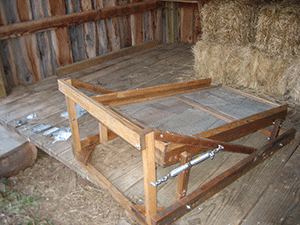
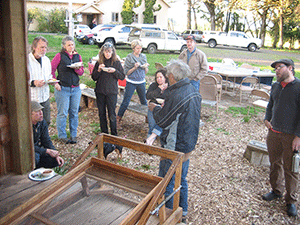
Two weeks after the Bean and Grain Project meeting, Steve Jones from Washington State's Bread Lab in Mount Vernon, Washington came to Eugene to speak to the Bread 101 class at the University of Oregon. While Steve was in town, he visited Lonesome Whistle Farm and Hunton Family Farm and Hunton's Camas Country Mill.
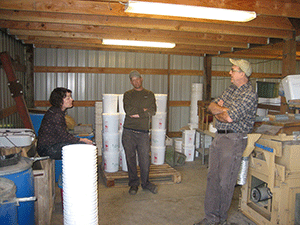
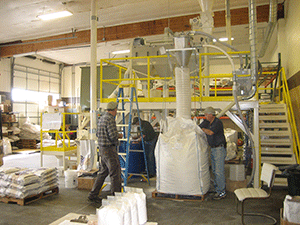
A visit by Steve Jones to the Willamette Valley is always welcome. The day of his farm tours, the professors who are teaching Bread 101 had a dinner for Steve that included four of the Bean and Grain Project farms–Sunbow Farm, Lonesome Whistle Farm, Hunton Family Farm, and Adaptive Seed Company. The dinner was excellent and the conversation even better with Andrew Still, Sarah Kleeger, Jeff Broadie, Kasey White, Tom and Sue Hunton, Harry MacCormack, and Cheri Clark joining Steve Jones at the table. Not surprisingly all the same topics discussed at the Bean and Grain Project meeting came up again–farm scale, young farmer financial security, and higher yielding wheat varieties for organic production.
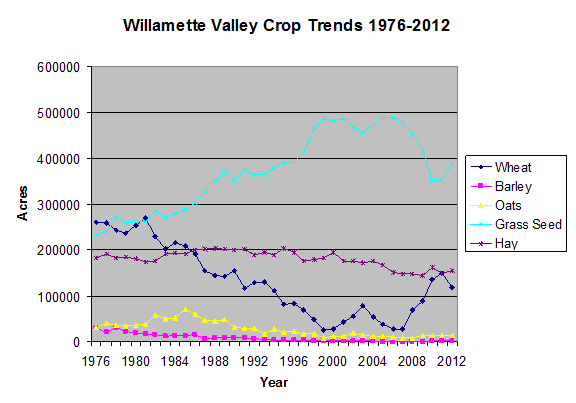
________________
As always, feedback to this webpage is welcome. If you attended either of the meetings, feel free to offer corrections or additions. In the end, the Bean and Grain Project meetings and these articles are meant as a forum about growing beans, grains, and edible seeds as field crops in the Willamette Valley. Discussion and the sharing of ideas are themes central to the project. Click to email.
Return to Bean and Grain Project Index.
Special thanks is extended to The Willamette Farm and Food Coalition and The Ten Rivers Food Web, The Evergreen Hill Fund of Oregon Community Foundation, and Hummingbird Wholesale for their continued support of the Southern Willamette Valley Bean and Grain Project.